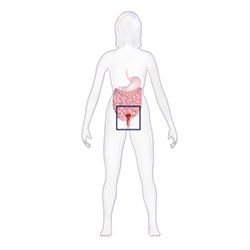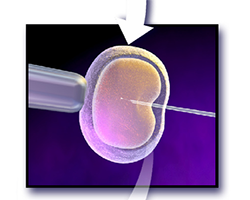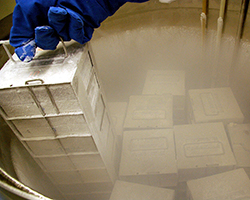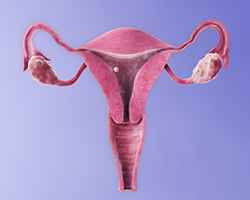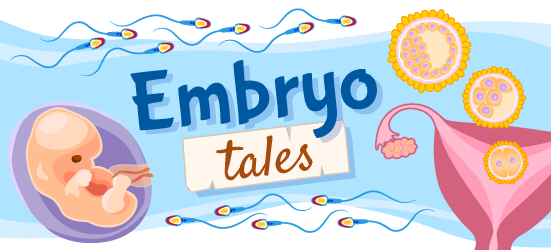
Focusing on Female Infertility
Illustrated by: Sabine Deviche
show/hide words to know
You grab a fistful of sunflower seeds, a tiny spade, and a green watering can, heading toward your garden. You bury the sunflower seeds and sprinkle water onto the ground. However, several days, then weeks, pass, and you can’t spot the tiniest sprout. What went wrong?

All organisms need specific conditions to grow. With sunshine, water, and the right air and nutrients, this sprout will grow into a large sunflower. Image by Amada44 via Wikimedia Commons.
Sunflowers need lots of sunshine, fresh water, and carbon dioxide to grow into the beautiful flower you want to see. And like your seeds, the human body also requires the right conditions for pregnancy.
Inside the ovaries are hundreds of thousands of small, immature eggs. Once a month, one egg matures and gets released from one of the ovaries. That process is called ovulation. The mature egg travels from the ovary through the fallopian tube. There, in some cases, the egg meets a sperm. If the egg and sperm fuse together, then a zygote forms. That’s called fertilization. The single-celled zygote divides into more cells until it forms an embryo. The embryo develops inside the uterus. There it receives nourishment to grow.
But what if fertilization doesn’t happen? Infertility is the inability to become pregnant after a year or more of trying. Usually women are the people who can become pregnant. But, anyone with a uterus can experience this type of infertility. In the Embryo Project article, “Assisted Reproductive Technologies,” writers explain why some women are infertile. They also describe the technologies that may help some people dealing with infertility to get pregnant.
Inspecting Infertility
There are several reasons why a person may not be able to become pregnant, such as age, low body weight, or health complications. When a person's menstrual cycle becomes irregular for any of these reasons, it is harder for them to get pregnant.
A condition called endometriosis can also make it harder for someone to get pregnant. That happens when the tissue that usually lines the inside of the uterus (and can nourish an embryo) grows outside of the uterus. That abnormal growth often causes very painful and heavy menstrual bleeding. And in some cases, the growths can also change the shapes of the fallopian tubes and uterus. That can mean that it is difficult for an egg to become fertilized or properly grow into an embryo.
Planning for Pregnancy
Luckily, people who might experience those conditions still have tools that may help them if they want to get pregnant. Some of those tools are called assisted reproductive technologies, or ARTs. Like water or beaming sunshine that help flowers bloom, ARTs can help to provide better conditions for pregnancy. There are many kinds of ARTs that help fertilization happen. Doctors can put sperm directly into the uterus or even the fallopian tubes close to ovulation, for example. But one of the most popular types of these technologies is called in vitro fertilization, or IVF.
IVF means fertilization that occurs outside of the body. In vitro is actually Latin for “in glass,” because during IVF, the egg and sperm cells fuse in a glass petri dish. This allows fertilization to occur. But before that can happen, a doctor must take the egg from the female body. To do that, the patient usually takes a medication called clomiphene citrate. It pushes the body to create estrogen, which helps ovulation happen. Ovulation is an essential step for pregnancy to occur.
The doctor uses ultrasounds and blood tests that let them know when the egg is ready. During that time, a male provides a sperm sample. Once the doctor retrieves the egg, a sperm can fertilize the egg inside the petri dish. The doctor transfers the newly fertilized egg back into the female patient’s body through the cervix and into the uterus. Later, the patient can take a pregnancy test to see if the IVF process succeeded.
Assisted reproductive technologies like IVF can help people with health problems who may have trouble ovulating.
The "Test Tube" Baby
On 25 July 1978, Lesley and John Brown welcomed their daughter Louise into the world. Louise’s birth seemed normal, but it was anything but that. Unlike most newborns, Louise was famous before she could even open her eyes. Louise received public attention because her parents were the first people to deliver a healthy baby using in vitro fertilization.
Before Louise’s birth, in 1976, Lesley found out that she had a blocked fallopian tube. Blocked fallopian tubes stop mature eggs from reaching the uterus. That made it hard for Lesley’s eggs to be fertilized.
The Browns eventually met Patrick Steptoe and Robert Edwards. They were physicians who used IVF to treat female infertility. Steptoe and Edwards collected eggs from Lesley Brown’s body and fertilized them in a glass petri dish. They later transferred one of those fertilized eggs back into her uterus. The successful process resulted in Lesley’s pregnancy with Louise. Following Louise’s birth, millions of others have given birth to healthy children using IVF.
Adopt an Embryo
Wait, doctors retrieve multiple eggs? But if a doctor only transfers one fertilized egg, then what happens to others? They are usually saved using a process called cryopreservation. That’s when doctors freeze the leftover fertilized eggs and store them.
IVF is often a lengthy and expensive process. Cryopreservation is helpful in case pregnancy fails or if a patient wants to use those fertilized eggs later for a second child. Doctors can also donate cryopreserved eggs to others who struggle to become pregnant, if the donor allows it.
Planning for Pregnancy
Scientists and doctors have studied female infertility and improved ARTs over time. In the early 1900s, doctors began to do intrauterine inseminations, or IUIs. During IUIs, doctors place sperm directly into the uterus. That is helpful for people who struggle to become pregnant through sexual intercourse, like couples with men who have low sperm counts.
After Steptoe and Edwards improved IVF, other ARTs started to become available. In the 1980s, doctors started to do similar things, with transfers into the fallopian tubes. In gamete intrafallopian transfers (GIFT), sperm is delivered into the tubes. In Zygote intrafallopian transfer (ZIFT), GIFT and IVF are basically combined. Doctors fertilize the egg with sperm in a petri dish. Then, they deliver the zygote into one of the fallopian tubes.
Around the world, millions of people struggle with infertility. However, medical breakthroughs have allowed some of those people to get pregnant. Many children are now being born using these assisted reproductive technologies.
This Embryo Tale was edited by Risa Schnebly and is based on the following Embryo Project articles:
Khokhar, Aroob, “Johns Hopkins Fertility Center.” Embryo Project Encyclopedia (2010-07-01). ISSN: 1940-5030 https://embryo.asu.edu/handle/10776/2023.
Lopez, Nicole, “National Embryo Donation Center.” Embryo Project Encyclopedia (2010-06-24). ISSN: 1940-5030 https://embryo.asu.edu/handle/10776/2027.
Van Iten, Brendan, "Estrogen and the Menstrual Cycle in Humans." Embryo Project Encyclopedia (2016-06-22). ISSN: 1940-5030 https://embryo.asu.edu/handle/10776/11344.
Zhu, Tian, "Assisted Reproductive Technologies." Embryo Project Encyclopedia (2009-07-22). ISSN: 1940-5030 https://embryo.asu.edu/handle/10776/1979.
Zhu, Tian, "Clomiphene Citrate." Embryo Project Encyclopedia (2009-07-25). ISSN: 1940-5030 https://embryo.asu.edu/handle/10776/1997.
Zhu, Tian, "In Vitro Fertilization." Embryo Project Encyclopedia (2009-07-22). ISSN: 1940-5030 https://embryo.asu.edu/handle/10776/1665.
Image of "Two Embryos" sculpture (Roel Bendijk) by Agaath via Wikimedia Commons.
View Citation

Be Part of
Ask A Biologist
By volunteering, or simply sending us feedback on the site. Scientists, teachers, writers, illustrators, and translators are all important to the program. If you are interested in helping with the website we have a Volunteers page to get the process started.







